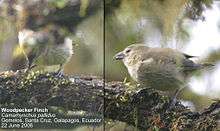Woodpecker finch
| Woodpecker finch | |
|---|---|
 | |
| Scientific classification | |
| Kingdom: | Animalia |
| Phylum: | Chordata |
| Class: | Aves |
| Order: | Passeriformes |
| Family: | Thraupidae |
| Genus: | Camarhynchus |
| Species: | C. pallidus |
| Binomial name | |
| Camarhynchus pallidus (Sclater & Salvin, 1870) | |
The woodpecker finch (Camarhynchus pallidus) is a species of bird in the Darwin's finch group of the tanager family Thraupidae. Woodpecker finches occur widely in the Galapagos Islands, from sea level to high elevations.

It has gained fame due to its capability of using a twig, stick, or cactus spine as a tool so it has been nicknamed the carpenter finch.[2] The tool is used as compensation for its short tongue. The finch manipulates the tool to dislodge invertebrate prey such as grubs from trees. The same tool can be used many times on many different trees. Scientists have observed that the finches may shorten the stick or spine to make it more manageable. The finches may also try various sticks or spines at one site before finding just the appropriate one that can reach and extract the prey item. A 2001 study shows that this behavior is possibly not acquired through social learning, as juveniles were able to use tools even without making contact with adults.[3]
Woodpeckers have strong bills for drilling and drumming on trees, and long sticky tongues for extracting food.[4] On the isolated Galapagos islands, without competition from South American woodpecker species, the woodpecker finch was able to adapt, and evolve its tool-utilizing capability to compensate for its short tongue.
During the dry season, woodpecker finches use tools during half their foraging time to acquire up to 50% of their prey. This means they obtain even more food via tool use than chimpanzees, the most proficient non-human primate tool users. Another bird with a somewhat similar capability of tool use is the New Caledonian crow.
Diet
The woodpecker finch is so-named because it feeds on small insects and grubs located within trees and shrubs. Its habit of pecking at branches is similar to a woodpecker's drumming on a tree trunk.
See also
References
- ↑ BirdLife International (2015). "Camarhynchus pallidus". IUCN Red List of Threatened Species. Version 2015. International Union for Conservation of Nature. Retrieved 24 January 2016.
- ↑ Darwin's Finches
- ↑ Do woodpecker finches acquire tool-use by social learning?. S. Tebbich, M. Taborsky, B. Fessl, and D. Blomqvist. US National Library of Medicine. Proc Biol Sci. Nov 7, 2001; 268(1482): 2189–2193.
- ↑ Winkler, Hans & Christie, David A. (2002), "Family Picidae (Woodpeckers)" in del Hoyo, J.; Elliot, A. & Sargatal, J. (editors). (2002). Handbook of the Birds of the World. Volume 7: Jacamars to Woodpeckers. Lynx Edicions. ISBN 84-87334-37-7
| Wikimedia Commons has media related to Camarhynchus pallidus. |
- Tebbich, S., Taborsky, M., Fessl, B. & Dvorak, M. 2002. The ecology of tool use in the woodpecker finch (Cactospiza pallida). Ecology Letters, 5, 656-664.
